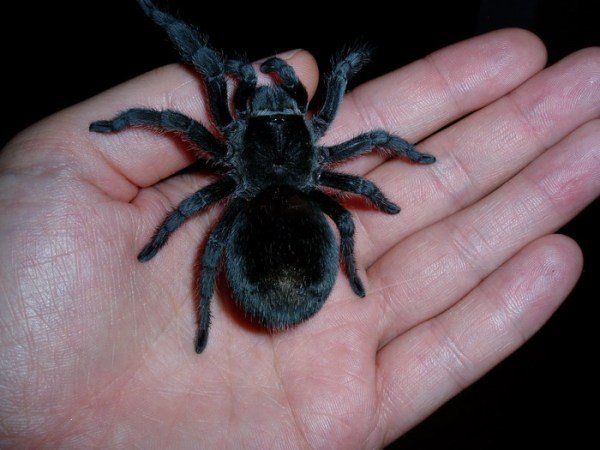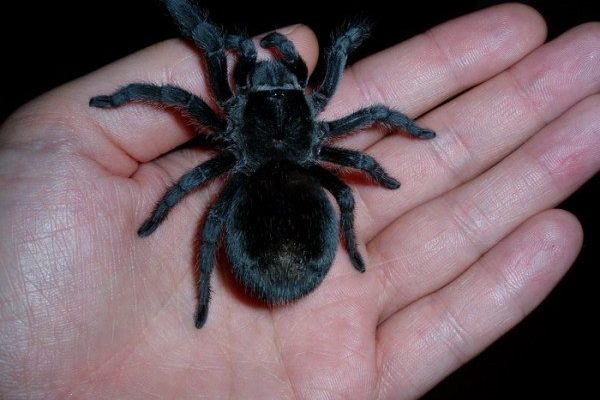
Now, before you start panicking about running into a tarantula during your next hike, let’s clear the air. While these spiders may seem daunting, they play a crucial role in their habitat by keeping the insect population in check. Understanding how to identify them can help you appreciate their beauty and importance. So, grab a cup of coffee, and let’s unravel the mystery of the Brazilian Black Tarantula together.
Physical Characteristics of the Brazilian Black Tarantula
When it comes to identifying the Brazilian Black Tarantula, the first thing you’ll notice is its striking appearance. These spiders can easily reach up to 4 to 5 inches in body length, with a leg span that can extend to a whopping 12 inches. That’s like having a small pizza on each side! Their bodies are covered in a silky, black sheen that appears almost velvety under the right light. This dramatic coloring is not just for show; it helps them blend into the dark, moist underbrush where they reside.
Next, let’s talk about their legs. The Brazilian Black Tarantula has long, slender legs that give it a delicate look, but don’t let that fool you—they’re incredibly strong. The legs are not just for show; they’re essential for hunting and climbing. If you see a spider that fits this description, it’s likely a Brazilian Black Tarantula. But look closely—those legs will have tiny hairs that help them sense vibrations in their environment. This sensitivity is crucial for detecting prey and avoiding predators.
One more thing to note is their unique eyes. Unlike some spiders that have multiple rows of eyes, the Brazilian Black Tarantula has eight eyes arranged in two rows. This arrangement gives them a wide field of view, which is helpful for spotting movement in their surroundings. If you’re ever lucky enough to observe one up close, you’ll notice how their eyes glisten, adding to their mystical appearance.
Behavior and Habitat
Brazilian Black Tarantulas are primarily ground dwellers, making their homes in burrows they dig in the soil or modify from existing ones. These burrows are like their personal castles—safe and cozy for resting during the day. Not only do they provide shelter, but they also help in hunting. By lurking in their burrows, they can ambush unsuspecting prey that wanders too close.
You might be wondering about their behavior. These tarantulas are nocturnal, meaning they come to life at night. They spend their evenings roaming their territory, searching for food. When it comes to hunting, they’re quite patient. Instead of spinning webs, they rely on their speed and agility to catch insects. You might see them in action if you’re out and about at dusk, but don’t get too close; they do have a reputation for being defensive if they feel threatened.
Interestingly, Brazilian Black Tarantulas are known for their docile nature, especially when handled carefully. However, like any wild animal, they can bite if provoked. It’s important to respect their space—appreciate their beauty from a distance, and you’ll enjoy observing them without any drama.
Common Misidentifications
As fascinating as the Brazilian Black Tarantula is, it’s easy to confuse it with other tarantulas or even non-tarantula species. One common mix-up is with the Goliath Bird Eater, which is one of the largest spiders in the world. While the Goliath Bird Eater has a more brownish hue with lighter hairs, the Brazilian Black Tarantula is distinctly black. If you catch a glimpse of a massive spider and can see more brown than black, it’s likely not the one you’re looking for.
Another potential mix-up could be with the Chilean Rose Tarantula, which has a more varied color palette, including browns and reds. While both species have a similar body structure, you’ll notice that the Brazilian Black Tarantula lacks the faintly reddish or lighter hairs that the Chilean Rose possesses. If you’re unsure, check the legs for that signature black sheen—this is a big giveaway.
Lastly, keep an eye out for spiders that resemble them, like the Common House Spider or the Wolf Spider. While these spiders can give off a similar vibe, their body shapes and colors differ significantly. House spiders typically have a more rounded body and a lighter coloration, while the Brazilian Black Tarantula is unmistakably robust and black.
Handling and Care
If you’re thinking about keeping a Brazilian Black Tarantula as a pet, it’s important to know how to handle them safely. Always remember to wash your hands before and after handling the spider to prevent any contamination. When picking them up, use a gentle touch and avoid grabbing them from above, as this can startle them. Instead, let the spider walk onto your hand; it’s a more comfortable and less stressful experience for both of you.
Providing proper care for a Brazilian Black Tarantula involves creating an environment that mimics their natural habitat. A terrarium with a substrate of coconut fiber or peat moss is ideal, as it allows them to burrow. Additionally, include a water dish for hydration and maintain humidity levels between 60-80%. Also, keep the temperature around 75-85°F.
Remember, feeding your tarantula is just as important as its habitat. They thrive on a diet of crickets and other insects, so be sure to provide them with adequate food. Monitor their eating habits because, like humans, they can have their off days. If your tarantula looks lethargic or refuses to eat, it might be time for a little health checkup.
Conservation and Importance
The Brazilian Black Tarantula isn’t just a fascinating creature; it plays a vital role in its ecosystem. By preying on insects, these spiders help control pest populations. This natural pest control is essential for maintaining the balance in their environment. Without spiders like the Brazilian Black, certain insect populations could explode, leading to overpopulation and potential crop damage.
Sadly, like many species, Brazilian Black Tarantulas face threats due to habitat loss from deforestation and human activities. While they may not be endangered yet, preserving their natural habitats is crucial for their survival. By understanding and respecting these spiders, we contribute to their conservation and, ultimately, the health of our planet.
If you’re an animal lover, visiting or supporting conservation programs that focus on these incredible spiders can make a difference. Every little action counts, whether it’s spreading awareness or participating in preservation efforts.
Identifying the Brazilian Black Tarantula can be an exciting adventure, whether you’re a wildlife enthusiast or simply curious about our eight-legged friends. With their striking appearance, fascinating behaviors, and essential role in nature, they’re worth appreciating from afar. Remember, while they might look intimidating, they’re simply doing their part in the ecosystem.
Next time you think about spiders, consider their beauty, importance, and the wonder of nature they represent. Who knows? You might just find yourself a little more curious the next time you stumble upon one in the wild or even as a pet. So, whether you’re hiking through the Amazon or browsing a pet shop, keep your eyes peeled for the Brazilian Black Tarantula and enjoy the marvels of nature that come with it!

